犀牛rhino跑车建模教程
- 格式:doc
- 大小:946.00 KB
- 文档页数:25

用Rhino做Shelby Cobra 轿车教程
本教程将演示如何制作Shelby Cobra轿车的车身。
其它
一些小部件如轮胎、油箱等本教程均作省略。
汽车造模时,最难的是车身,因为它一般都是非常光滑的曲面。
用Rhino来做此项工作,是个不错的主意
仔细观察上面的一幅图片,你不难发现它象是汽车车身的廓线。
它们能帮助完成最后的造模工作。
与多边形造模不同,NURBS曲面造模就是靠这样的样条曲线来勾描图形的。
仔细观察上面的一幅图片,你不难发现它象是汽车车身的廓线。
它们能帮助完成最后的造模工作。
与多边形造模不同,NURBS曲面造模就是靠这样的样条曲线来勾描图形的。
根据车身形状用一条非封闭的曲线画出它的横截面图
拷贝刚才画的曲线生成第二条横截面曲线,并将它向下移动一些,修改若干控制点,形成的结果如上图。
依此类推,根据车身形状,画出其不同区段的横截面曲线,以备下一步放样用。
用画出的这些曲线进行放操作,结果如上图所示。
如上图所示用拉伸(Extrude)曲线的方法,在车头部分挖出一个口子,形成汽车散热器及保
险杠的形状。
用同新的拉伸样条曲线的方法在车身上挖出蔽蓬车座的位置。
如上图,画出车轮箱处的弧形边线,再做一次拷贝,并将拷贝的曲线缩小,稍稍移离车体,然后放样这两条曲线,形成车体车轮箱处略微突出的边缘。

rhino 教程Rhino是一款功能强大的3D建模软件,它提供了丰富的工具和功能来创建复杂的几何形状。
在本教程中,我们将介绍Rhino的一些基本操作和常用工具,帮助你快速上手这款软件。
1. Rhinoceros的界面打开Rhinoceros后,你将看到一个多窗口的界面。
主要窗口是3D视图窗口,用于查看和编辑实际的3D模型。
在这个窗口中,你可以使用鼠标进行旋转、缩放和平移操作。
2. 创建基本几何形状在Rhino中,你可以使用基本几何形状工具来创建简单的形状,比如立方体、球体、圆柱体等。
选择相应的工具,并在3D视图窗口中点击并拖动鼠标来定义形状的大小和位置。
3. 修改几何形状一旦你创建了一个几何形状,你可以使用Rhino提供的编辑工具来修改它。
比如,你可以选择形状的某个面或边,然后通过拉伸、旋转等操作来改变它的形状。
4. 组织和管理对象在Rhino中,你可以使用图层和组来组织和管理你的模型。
图层可以帮助你将对象分类和分组,使得你能更好地控制和编辑它们。
而组可以将多个对象组合在一起,形成一个整体。
5. 渲染和展示模型Rhino提供了强大的渲染功能,可以帮助你将模型以更真实的形式呈现出来。
你可以设置材质、光照和相机等参数,来调整模型的外观和效果。
6. 导入和导出模型Rhino支持多种文件格式的导入和导出,比如DWG、STL、OBJ等。
你可以将Rhino中的模型导出为其他软件能够识别的格式,或者从其他软件导入模型到Rhino进行编辑和处理。
7. 进阶技巧和工具除了基本功能和操作外,Rhino还提供了许多高级工具和技巧,可以帮助你更高效地进行建模工作。
比如,你可以使用Rhino脚本语言来自动化一些重复性的操作,或者使用Rhino的插件来扩展软件的功能。
通过掌握这些基本操作和技巧,你将能够快速上手Rhino,并在其中创建复杂的3D模型。
希望这个教程能够对你有所帮助,祝你在Rhino中有愉快的建模体验!。
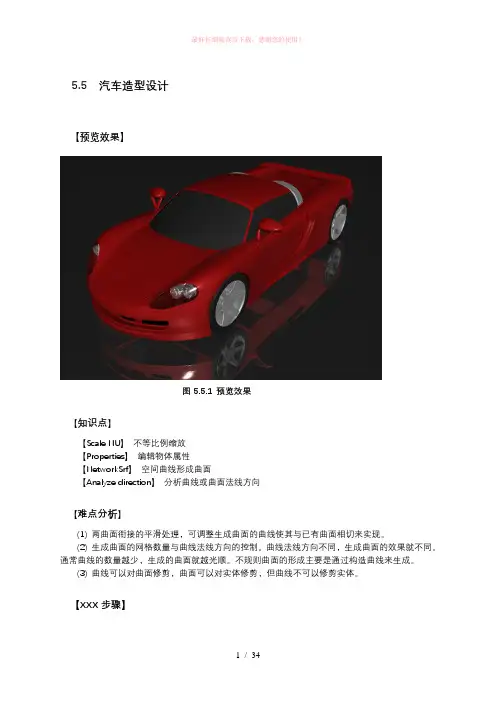
5.5 汽车造型设计【预览效果】图5.5.1 预览效果【知识点】【Scale NU】不等比例缩放【Properties】编辑物体属性【NetworkSrf】空间曲线形成曲面【Analyze direction】分析曲线或曲面法线方向【难点分析】(1) 两曲面衔接的平滑处理,可调整生成曲面的曲线使其与已有曲面相切来实现。
(2) 生成曲面的网格数量与曲线法线方向的控制。
曲线法线方向不同,生成曲面的效果就不同。
通常曲线的数量越少,生成的曲面就越光顺。
不规则曲面的形成主要是通过构造曲线来生成。
(3) 曲线可以对曲面修剪,曲面可以对实体修剪,但曲线不可以修剪实体。
【XXX步骤】5.5.1 车身1) 新建图层单击,在对话框中新建如图5.5.2所示的6个图层,选择车身表面为当前图层。
图5.5.2 设置图层2) 绘制车身骨架曲面(1) 绘制平面曲线。
单击,结合三视图绘制三条平面曲线,如图5.5.3所示。
图5.5.3 绘制平面曲线(2) 绘制汽车框架曲线。
在【Top】视图沿垂直方向和水平方向对三条平面曲线分别进行复制。
如图5.5.4所示。
图5.5.4 绘制框架曲线(3) 绘制平面曲线。
激活【Top】视图,单击,绘制平面曲线,如图5.5.5所示。
图5.5.5 绘制平面曲线(3) 一轨成型生成曲面。
单击,以图5.5.5绘制曲线为轨迹一轨成型生成曲面,对话框设置为rebuild with 10 control points,生成半个粗略车身侧面。
如图5.5.6所示。
(4) 提取曲面结构线。
激活【Top】视图,单击,选择车身侧面曲面,在车身侧面曲面上提取多条结构线。
如图5.5.7 所示。
图5.5.6 一轨成型生成曲面图5.5.7 提取曲面结构线(5) 删除车身侧面曲面及图5.5.5与图5.5.4所绘曲线。
如图5.5.8所示。
图5.5.8 提取后的曲线(6) 重建曲线控制点。
单击,框选所有曲线,重建曲线控制点。
对话框设置如图5.5.9所示。
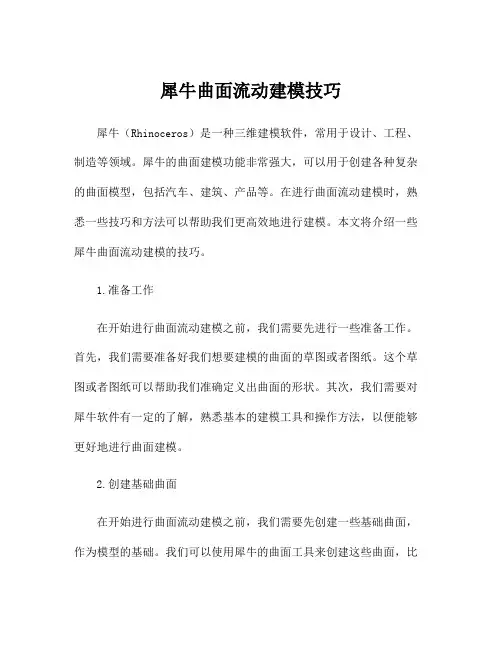
犀牛曲面流动建模技巧犀牛(Rhinoceros)是一种三维建模软件,常用于设计、工程、制造等领域。
犀牛的曲面建模功能非常强大,可以用于创建各种复杂的曲面模型,包括汽车、建筑、产品等。
在进行曲面流动建模时,熟悉一些技巧和方法可以帮助我们更高效地进行建模。
本文将介绍一些犀牛曲面流动建模的技巧。
1.准备工作在开始进行曲面流动建模之前,我们需要先进行一些准备工作。
首先,我们需要准备好我们想要建模的曲面的草图或者图纸。
这个草图或者图纸可以帮助我们准确定义出曲面的形状。
其次,我们需要对犀牛软件有一定的了解,熟悉基本的建模工具和操作方法,以便能够更好地进行曲面建模。
2.创建基础曲面在开始进行曲面流动建模之前,我们需要先创建一些基础曲面,作为模型的基础。
我们可以使用犀牛的曲面工具来创建这些曲面,比如Bezier曲线、NURBS曲面等。
通过这些基础曲面,我们可以在其上进行进一步的操作和修改,以得到我们想要的曲面效果。
3.使用控制点编辑曲面在犀牛中,我们可以使用控制点来编辑曲面。
通过调整曲面上的控制点,我们可以改变曲面的形状和曲率。
在曲面流动建模中,我们经常需要对曲面进行微调和修改,以获得更加符合设计要求的曲面形状。
使用控制点编辑工具,可以方便地对曲面进行编辑。
4.使用曲线和几何图形辅助建模在进行曲面流动建模时,我们可以使用曲线和几何图形来辅助建模。
例如,我们可以使用切线曲线来定义曲面上的平行线,从而实现曲面上定距离点的生成。
另外,我们也可以使用曲线进行切线操作,从而实现曲面上的快速修整。
这些方法可以大大提高我们的建模效率。
5.使用犀牛的插件扩展功能犀牛有许多插件可以帮助我们扩展其功能,从而实现更复杂的曲面流动建模。
例如,可以使用犀牛的T-splines插件来进行曲面变形和细化,从而实现更加复杂的曲面流动。
另外,还可以使用犀牛的Grasshopper插件来进行参数化建模,从而实现曲面流动建模的自动化和智能化。
6.注意曲面的平滑和过渡在进行曲面流动建模时,我们需要特别注意曲面的平滑和过渡。
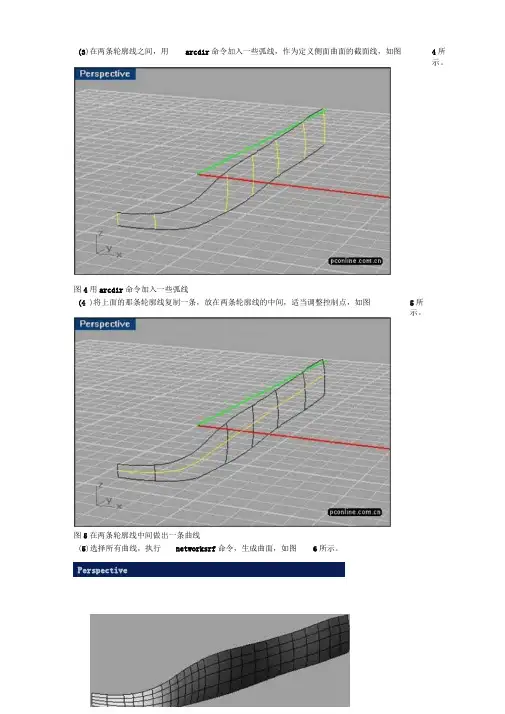
图5在两条轮廓线中间做出一条曲线(5)选择所有曲线,执行networksrf命令,生成曲面,如图6所示。
Perspective4所示。
(3)在两条轮廓线之间,用arcdir命令加入一些弧线,作为定义侧面曲面的截面线,如图图4用arcdir命令加入一些弧线5所示。
(4 )将上面的那条轮廓线复制一条,放在两条轮廓线的中间,适当调整控制点,如图在这个教学里,将简单介绍用rhino制作跑车的基本方法。
图1用rhino制作的跑车(1)在侧面视图里,绘制出侧面的两条轮廓线,如图2所示。
图2画出两条车体的轮廓线(2)在上视图里,打开两条轮廓曲线的控制点,适当调整控制点,如图2所示。
在调整控制点的同时,可以根据需要,用insertknot 命令给曲线加入控制点。
图3在上视图里面调整控制点6)用mirror命令镜象出另外半边的曲面,执行mergesf命令,将两个曲面合而为一,如图7所示。
图7用mergesf命令将两个曲面合而为(7)如图8所示,画出一序列的曲线。
PerspertivE图8画出一序列的曲线(8)执行sweep2命令,产生曲面,注意选择上一步骤画出的一序列的曲线的中间那条面的边界作为rail的路径线,然后选择出的围绕在U字形曲线的一序列的曲线作为曲面,如图9所示。
U字形的曲线和前面产生的曲cross section 的截面线,产生图9用sweep2命令产生曲面9)执行matchsrf命令,选择刚才用sweep2产生的曲面,然后再选择它下面的曲面,对话框里面,选择Tangency和Refine match 其他都不要选,如图10所示。
图10用matchsrf命令匹配两个曲面(10)在上视图里面,画出一条曲线,然后镜象出另外一边的曲线,如图11所示。
图11在上视图里面做出对称的一对曲线(11)执行trim 命令,用上一步骤产生的那对曲线来剪切车体上部的曲面,如图12所示。
PsrsijeiJlYe进行曲面匹配,在match surface图12用trim 命令剪切车体上部曲面12)在车头通风口处,画出两条直线,用 trim 命令将下面的曲面剪切出一个开口来,如图 图13在通风口处剪切出一个开口来(13)如图14所示,画出4条曲线,用networksrf 命令产生一个曲面。

犀牛汽车建模教程简介汽车建模是计算机图形学的重要应用之一,也是产品设计与开发过程中的重要环节之一。
本教程将以犀牛(Rhinoceros)软件为例,介绍汽车建模的基本流程和技巧。
1. 准备工作在开始之前,我们首先需要准备好以下工具和素材: - 犀牛软件:你可以从官网下载犀牛软件,并按照官方指引进行安装。
- 参考图:你可以从互联网上搜索到你想要建模的汽车的参考图,并保存到电脑上。
2. 导入参考图在犀牛软件中,我们需要将参考图导入到建模场景中,以便参考和绘制。
2.1 打开犀牛软件双击打开犀牛软件,启动软件。
2.2 导入参考图在软件的菜单栏中,选择“文件”->“导入”,然后选择你保存在电脑上的参考图文件,点击“打开”按钮。
参考图将会被导入到犀牛场景中。
2.3 调整参考图位置和大小在犀牛的“命令行”中输入“PictureFrame”命令,然后按照提示选择导入的参考图,接着按照需要调整参考图的位置和大小。
3. 建立基本几何体在开始绘制汽车的外观之前,我们首先需要建立一些基本几何体,以便参考和操作。
3.1 绘制车轮轮廓选择犀牛的“曲线”工具,绘制出车轮的轮廓。
可以参考参考图来确定轮廓的形状。
3.2 创建车身基础结构使用犀牛的“面”工具,根据参考图的形状,绘制出汽车的车身基础结构。
可以使用直线和曲线来绘制多边形。
3.3 创建车窗和灯光使用犀牛的“曲面”工具,根据参考图的形状,绘制出汽车的车窗和灯光。
4. 细化和调整设计在完成基本的汽车外观建模之后,我们可以对细节进行调整和优化。
4.1 平滑曲线和曲面使用犀牛的“平滑”功能,对汽车的曲线和曲面进行平滑处理,使其更加真实和光滑。
4.2 添加细节使用犀牛的“细化”功能,添加汽车的细节,如车灯、车窗的细节等。
4.3 调整比例和比例根据需要,使用犀牛的“缩放”和“旋转”功能,调整汽车的比例和角度,使其符合设计需求。
5. 渲染和导出在完成汽车建模之后,我们可以进行渲染和导出,以便进行展示和分享。
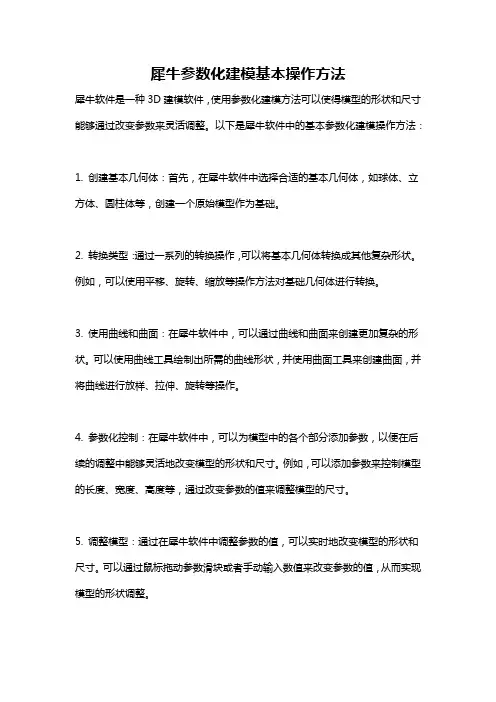
犀牛参数化建模基本操作方法犀牛软件是一种3D建模软件,使用参数化建模方法可以使得模型的形状和尺寸能够通过改变参数来灵活调整。
以下是犀牛软件中的基本参数化建模操作方法:1. 创建基本几何体:首先,在犀牛软件中选择合适的基本几何体,如球体、立方体、圆柱体等,创建一个原始模型作为基础。
2. 转换类型:通过一系列的转换操作,可以将基本几何体转换成其他复杂形状。
例如,可以使用平移、旋转、缩放等操作方法对基础几何体进行转换。
3. 使用曲线和曲面:在犀牛软件中,可以通过曲线和曲面来创建更加复杂的形状。
可以使用曲线工具绘制出所需的曲线形状,并使用曲面工具来创建曲面,并将曲线进行放样、拉伸、旋转等操作。
4. 参数化控制:在犀牛软件中,可以为模型中的各个部分添加参数,以便在后续的调整中能够灵活地改变模型的形状和尺寸。
例如,可以添加参数来控制模型的长度、宽度、高度等,通过改变参数的值来调整模型的尺寸。
5. 调整模型:通过在犀牛软件中调整参数的值,可以实时地改变模型的形状和尺寸。
可以通过鼠标拖动参数滑块或者手动输入数值来改变参数的值,从而实现模型的形状调整。
6. 添加约束:在犀牛软件中,可以添加约束来限制模型的一些属性。
例如,可以添加关系约束来确保模型的各个部分保持相对位置不变,或者添加数值约束来限制参数的范围。
7. 参数化关联:可以使用参数化关联方法来使得模型中的各个部分之间相互关联。
例如,可以通过定义参数之间的关系来实现模型中的一部分随着另一部分的变化而实时更新。
通过以上的参数化建模基本操作方法,可以在犀牛软件中灵活地进行模型的设计和调整,使得模型的形状和尺寸可以快速改变,提高了建模的效率和灵活性。
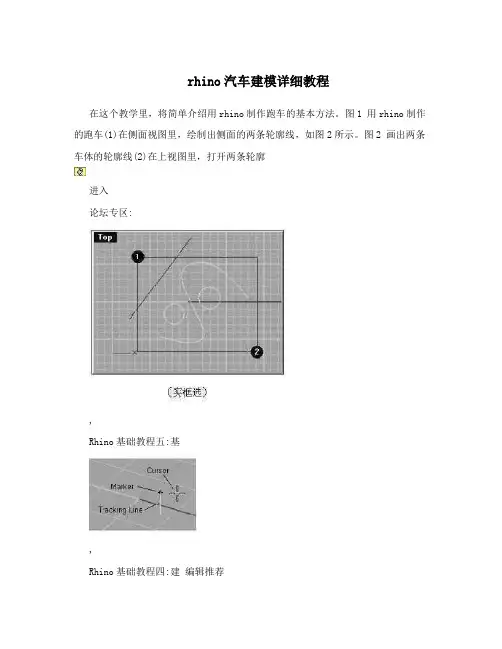
rhino汽车建模详细教程在这个教学里,将简单介绍用rhino制作跑车的基本方法。
图1 用rhino制作的跑车(1)在侧面视图里,绘制出侧面的两条轮廓线,如图2所示。
图2 画出两条车体的轮廓线(2)在上视图里,打开两条轮廓进入论坛专区:,Rhino基础教程五:基,Rhino基础教程四:建编辑推荐在这个教学里,将简单介绍用rhino制作跑车的基本方法。
图1 用rhino制作的跑车 (1)在侧面视图里,绘制出侧面的两条轮廓线,如图2所示。
图2 画出两条车体的轮廓线(2)在上视图里,打开两条轮廓曲线的控制点,适当调整控制点,如图2所示。
在调整控制点的同时,可以根据需要,用iertknot命令给曲线加入控制点。
图3 在上视图里面调整控制点(3)在两条轮廓线之间,用arcdir命令加入一些弧线,作为定义侧面曲面的截面线,如图4所示。
图4 用arcdir命令加入一些弧线(4)将上面的那条轮廓线复制一条,放在两条轮廓线的中间,适当调整控制点,如图5所示。
图5 在两条轮廓线中间做出一条曲线(5)选择所有曲线,执行networksrf命令,生成曲面,如图6所示。
图6 用networksrf命令产生曲面(6)用mirror命令镜象出另外半边的曲面,执行mergesrf命令,将两个曲面合而为一,如图7所示。
图7 用mergesrf命令将两个曲面合而为一(7)如图8所示,画出一序列的曲线。
图8 画出一序列的曲线(8)执行sweep2命令,产生曲面,注意选择上一步骤画出的一序列的曲线的中间那条U字形的曲线和前面产生的曲面的边界作为rail的路径线,然后选择出的围绕在U字形曲线的一序列的曲线作为cro section的截面线,产生曲面,如图9所示。
图9 用sweep2命令产生曲面(9)执行matchsrf命令,选择刚才用sweep2产生的曲面,然后再选择它下面的曲面,进行曲面匹配,在match surface对话框里面,选择Tangency和Refine match其他都不要选,如图10所示。
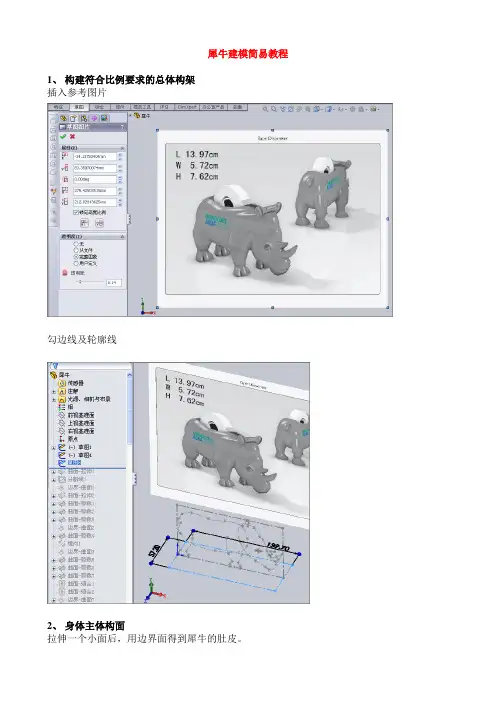
犀牛建模简易教程1、构建符合比例要求的总体构架
插入参考图片
勾边线及轮廓线
2、身体主体构面
拉伸一个小面后,用边界面得到犀牛的肚皮。
做好每一个面,隐藏不需要的面,以免影响下一步操作。
3、构建犀牛头
同样拉伸一个小面后,用边界面得到头部。
经过前面这几步,得到如下结果:
裁剪身体前端部分,留出颈部位置。
还是用边界面连接身体和头部,得到颈部曲面。
然后缝合,镜像得到主体部分完整结构。
5、构造四条腿
首先构造脚
用放样得到整条右后腿。
用同样的办法得到右前腿
然后是缝合,再镜像得到完整的四条腿。
6、做出剩余小特征
用边界面做吻部
及唇部
扫描得到牛鼻孔
扫描得到犀牛角
头部合适位置切除眼睛,再拉伸一个圆柱,圆柱顶面用圆顶做出眼球。
填充刚才切出来的眼睛孔
放样得到外眼皮
裁剪多余面,镜像到左侧再缝合成实体。
放样得到犀牛耳朵
抽壳以后得到耳朵造型,再镜像到左侧。
用放样构建牛尾巴
最后就是组合得到整头犀牛了。
2009年6月7日。
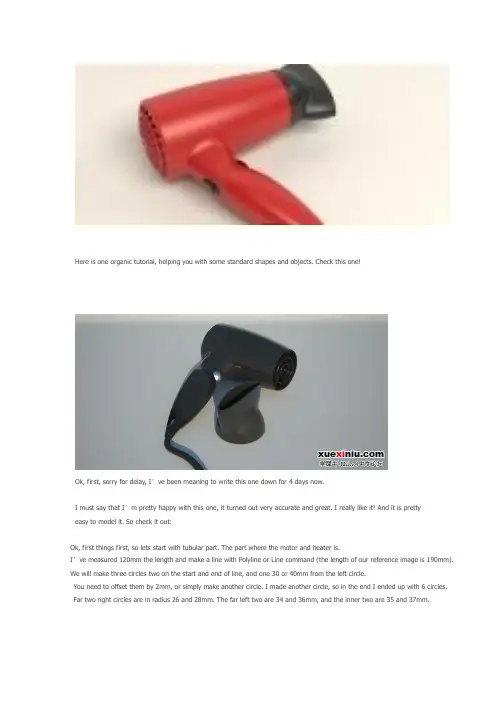
Here is one organic tutorial, helping you with some standard shapes and objects. Check this one!Ok, first, sorry for delay, I’ve been meaning to write this one down for 4 days now.I must say that I’m pretty happy with this one, it turned out very accurate and great. I really like it! And it is prettyeasy to model it. So check it out:Ok, first things first, so lets start with tubular part. The part where the motor and heater is.I’ve measured 120mm the length and make a line with Polyline or Line command (the length of our reference image is 190mm). We will make three circles two on the start and end of line, and one 30 or 40mm from the left circle.You need to offset them by 2mm, or simply make another circle. I made another circle, so in the end I ended up with 6 circles. Far two right circles are in radius 26 and 28mm. The far left two are 34 and 36mm, and the inner two are 35 and 37mm.Using InterpCrv command make a line connecting three outer circles. (use Quad option in Osnap for easier snapping). Next, do the same step for 3 inner circles.Using Sweep2 for first and second rail select outer two circles, and for cross section curve select Curve we made earlier. Make an ellipse and position it like on the image below:Next, from Front viewport use Project command to project that ellipse onto our tubular surface. You will get two curves on the surface, and we need only the front one. Using it, we will trim the surface and make a hole:Now, we’ll move onto handle. I like jumping from one part to another, I guess you already found that outFrom top viewport using reference image, outline outer edges with InterpCrv. Just to make sure, I made a straight horizontal linein Top viewport (using Ortho) and trimmed off the two curves. Now, we are sure those two curves has endings in the same cplane.Create another ellipse, this time one radius 15mm and other 13mm. Using End and Quad options in Osnap, position the ellipsebetween two curves, first move it to the end of one curve, and using PointsOn command, stretch the ellipse to fit the other curve’s end.Copy that ellipse, and position it like on the image below. You also need to stretch it with moving control points so it touches both curves.I have also made this ellipse 4 points higher. So, select upper three control points and move them 4 units up,and then move lower three control points and move them by 4 units (mm) down.Next, using that second bigger ellipsoid and two handle curves, we will make a sweep2.Using DupBorder we will duplicate border of newly created surface. We will get two closed curves, and we need the little one only, as we already have the bigger one. So, now, delete the surface, and again create sweep2 rail between two rail curves,and using now three closed curves:And now, we have a handle! Next, we will blend the two surfaces, so use BlendSrf command. Note that we need to check the Same height shapes option:Hopefully you got something like on the image below:Now, lets cap the tubular part.From the end of the first Line we created in this tutorial, create another line, and make it 10units (mm) long.Now, using Quad option in Osnap create InterpCrv (Curve: Interpolated Points) between two Quad points as start and end, and in the middle top of the 10mm long line:Trim one half of the newly created curve (arch) with 10mm long line, and that half arch needs to be revolved.I used Sweep1 and followed outer circle. But before that, we need to offset that half arch,and we need to move the inner circle by 2mm right from Top viewport(2mm will be the thickness of our shell - yeah, we still need to do that manually ).Now, we can use Sweep1 and make two surfaces:Ok, now, we will make little holes on the rear. From Right viewport make an ellipse 5×2.5mm. Rotate it for 45 degrees, and position like on the image:Using ArrayPolar make an array of 24 holes. Naturally the center would be the same center of circular surfaces.Next, using Copy and Paste duplicate those 24 ellipses, and using Scale shrink them,so you have 5 rows of 24 ellipses each row smaller than the previous.I have grouped each row of ellipses, and will extrude them one group at the time so I have more control, and less mess. So, extrude the ellipses and trim with two circular surfaces:Now, we will make just the same handle and tubular surface, but 2mm smaller.Using all those smaller circles, and smaller curves, we will make inner side of our dryer.You could use offset, but when using it curves are often made out of too much control points,and therefore your surfaces end up with much more isoparms, and we want our models cleaner.You could use Rebuild to make curves better, but then you might loose the original position of your curves. It is a bit tricky, and recreating all the curves, but 2mm smaller is a lot better way.Now, we need to blend the inner and outer surface where the air blows out.Next, on the part where the air is sucked in, using FilletEdge and 2mm as radius round that edge:Lets get back to our first 120mm long line. On the other end (the end there the air blows out from the dryer) create another circle with radius of 6.5mm. The second one from the same center but with 8mm as radius, and another one with radius of 10mm, then one with 16, and one with 18mm radius.Extrude those 5 circles by -15mm (minus is because we need it to go left when looking at it from Top viewport). Do not use Cap option.Next, you will blendsrf paired circles.The one in the middle, the smallest circle, using Arc command we will make an arc like on the image below:Using sweep1 command make a cap:Using Line or Polyline mimic the image below. I first created one line through the center,and then copied it and rotated by 90 degrees, next, I copied those two and rotated by 45 degrees. Next, each line I offset by 1mm up and down, and deleted the middle line.I have also offset the outer circle by 2mm, and aligned everything in the same cplane.And for the end of this part we will extrude those curves by 5mm with Cap option set to yesNow, lets make a little hole in the handle. For hanging the dryer on the wall or something. Create a closed curve like on the image below and trim what is inside:We will make three cross section curves, actually two lines, and one curve and using Sweep2 make a surface: (don’t forget to use Closed sweep option)Join that surface with handle surface, and fillet the two edges with 0.5mm radius:Next, lets create a curve for splitting the handle:Offset that curve by 0.3mm, and trim off what is between two curves:Now we need to blend the inner and outer shell surface (for both sides same settings):hair_dryer_41.jpg(67 KB, 下载次数: 21)STEP 4In this step we will be dealing with dryer cap that concentrates the hot air direction. We will use outer circle of right side of our tubular part:This circle needs to be offset by 4mm to the inside. From the center of this circle start a line 35mm long:Again, using InterpCrv make a curve starting from one Quad point on outer circle,middle of it is in the end of line, and the end of this curve is in the opposite Quad point.From the end and start make two lines. Having Ortho set to on helps!hair_dryer_45.jpg(22 KB, 下载次数: 16)Now, using Match, match the curve to both lines, and set the Continuity and Preserve other end to Tangency. hair_dryer_46.jpg(46 KB, 下载次数: 20)(Note: if you want to match the one end of a curve to the line, then you need to first click near the one end on the curve, then on the line) Using the line that is in the center (you might need to move it to the right a little - just so it crosses your curve (arch)) trim the curve.Use Sweep1 to rail revolve and make a cap.hair_dryer_48.jpg(21 KB, 下载次数: 13)Next, make an ellipse. First end of axis is at 77m, and second at 22mm.(select Diameter from command options selection). And then make another ellipse,again use Diameter, and set 48×14mm. Position both centres of these two ellipses in the same point.hair_dryer_49.jpg(36 KB, 下载次数: 15)I have positioned the both centres of two ellipses to the center of our cap, and then I moved it to the right a little:Now, move the inner ellipse for 42mm to the inside:hair_dryer_51.jpg(27 KB, 下载次数: 14)Using InterpCrv, create a curve between two coplanar Quad points on two ellipses. Now it seems like it is a line,but if you turn on the control points you will get two more cpoints in side this so called line, select two and move outside a little:Using Sweep2 use two ellipses as rail curves, and one connecting curve as cross section. hair_dryer_53.jpg(30 KB, 下载次数: 18)Trim the parts we don’t need:Now, we will make a fillet between these two surfaces… First I joined these two as I wanted to make a FilletEdge, but that didn’t turn out good, so I Exploded the mesh, and made a FilletSrf between these two surfaces.The radius was 10mm and everything went well. If you encounter problems with both FilletEdge and FilletSrf,try reducing od increasing the radius, and if that doesn’t work either, then try the pipe method.hair_dryer_55.jpg(28 KB, 下载次数: 15)Now, using the same exact method we did before for shelling, we will make a shell for this dryer part.Then, we will make one big circle from the center of our little part:hair_dryer_56.jpg(63 KB, 下载次数: 20)Still in the top viewport, we will Trim off the cap, so we get that round edge and BlendSrf the edges(you can either try JoinEdge command to join broken edges, or you can blend 4 time, and then join everything):Now, on the back of this part, make a cross section curve like on the image below: Use polyline hair_dryer_58.jpg(38 KB, 下载次数: 19)And using Sweep2, make a surface:Then, you can fillet the edges.hair_dryer_60.jpg(74 KB, 下载次数: 15)STEP 5Start with ellipse in Right viewport. (Click on diameter option) and input for end of first axis 32mm, and for end of second axis 16mm.Now, using Rectangle (select Rounded option) make a rectangle (first length 20mm, and second 13mm, and center it in the center of our ellipse: hair_dryer_62.jpg(42 KB, 下载次数: 16)Rotate the two curves from top viewport, and extrude with no other extrusion options: hair_dryer_63.jpg(87 KB, 下载次数: 17)Trim the inner part of outer shell of our dryer with extruded ellipse, and split the inner shell of dryer with extruded rounded rectangle:Loft the edges:hair_dryer_65.jpg(34 KB, 下载次数: 16)Fillet the Edge with 1mm radius.Now, create this little rounded rectangle, and position it like on the image:hair_dryer_67.jpg(21 KB, 下载次数: 15)Project it on the blue surface, and extrude that projected curve by 3mm (-3mm) and make a cap with Patch command. hair_dryer_68.jpg(26 KB, 下载次数: 16)STEP 6And for the end, we will make another button. The first one was for controlling the fan speed, and this one is On/Off button. So, create an Ellipsoidhair_dryer_69.jpg(73 KB, 下载次数: 19)Offset that ellipsoid with OffsetSrf command by 0.5mm towards outside. With the bigger ellipsoid trim the handle:Fillet the edges with 0.4mm, and you’re donehair_dryer_71.jpg(89 KB, 下载次数: 19)。
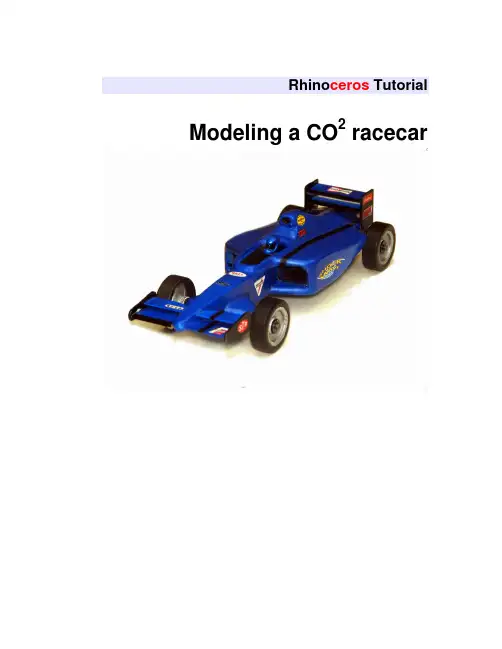
Rhino ceros Tutorial Modeling a CO2 racecarCopyright © 2005 Robert McNeel & Associates. All rights reserved.Rhino ceros is a registered trademark and Rhino is a trademark of Robert McNeel & Associates.Table of Contents1Introduction (4)Template files (4)2Model a CO2 Racecar for beginners (5)Starting a Model with a Template (5)Making the body of the racecar (7)Adding details to the racecar (13)3Model a CO2 racecar for intermediate users (17)Starting a Model with a Template (17)Placing the background bitmaps (19)Making the 2D geometry (20)Making the body of the racecar (28)Adding details to the racecar (32)4Preparing the model for machining (36)To make a stock box (37)Milling strategy (40)5Making a wheel and tire (41)To make the wheel (42)To make the tire (43)1 IntroductionThis tutorial describes how to model a racecar using Rhinoceros.There are several templates provided for your use. Each template includes a set ofpredefined layers to help you organize your model.Layers are a way of organizing objects so you can manipulate all the objects on aparticular layer or keep track of them. When objects are on a layer, you can turn them all off at once, change the color of the wire frame display, and select them all with oneselection.For more information about layers refer to the Rhino help file.Each of the templates has a layer with a set of wheels and axles and another layer witha model of a standard CO2 cartridge.Each template also has a layer named Max size that has rectangles that show themaximum size limits for the racecar. Your geometry must stay within these rectangles.You can turn the layers on or off at any time. Use the rectangles on these layers to check the size and positioning of your model.Template filesPlace the files that were included with the tutorial in a folder on your hard drive.Remember where they are located for later use.The files provided with this tutorial are:•Racecar.pdf•Beginner Racecar template inch.3dm•Beginner Racecar template mm.3dm•Beginner Racecar finished.3dm•Intermediate Racecar template inch.3dm•Intermediate Racecar template mm.3dm•Intermediate Racecar finished.3dm•Racecar Top.png•Racecar Front.png•Racecar Right.png2 Model a CO2 Racecar for beginnersIn this part of the tutorial you will learn how to: •Open a rhino model•Save a model•Turn layers on and off•Create surfaces•Trim and join the surfaces to form the body of the racecar.•Extrude the cockpit curves to cutoutthe cockpit from the body.•Extrude the strut curves to add to the body•Use Boolean operations•Use a cylinder to cut out the opening for the CO2cartridgeStarting a Model with a TemplateWhen starting a model in Rhino you can select a template. In this part of the tutorial you will select the Beginner Racecar Template Inch.3dm to begin the modeling process.Templates contain information that helps you get started such as units, layers, viewport layouts, and toolbars.LayersThe Racecar template for beginners includes seven predefined layers. Layers are a way of organizing objects so you can manipulate them separately or keep track of them in some way. It may help you to think of layers as transparent sheets on which you can place different parts of your model.The predefined layers have color properties that will let you distinguish various parts of the model more easily. In this template, all but one of the predefined layers includes construction geometry.Objects on a layer that is On are visible in the graphics area. Objects on a layer that is Off are not visible. Objects that are on an Unlocked layer are selectable. Objects on a layer that is Locked are not selectable. Geometry can only be created on the current layer.•The Max Size layer is on and locked. This layer contains rectangles that define the overall size of the racecar.•The Top Curves layer has geometry that defines the shape of the racecar.This layer correlates with the Top viewport.•The Front Curves layer contains the geometry to make surfaces for the struts and the cutout for the cockpit of the racecar. This layer correlates withthe Front viewport.•The Right Curves layer contains geometry with which to make the surface of the racecar’s topside. It also has curves for both the location of the CO2cartridge and the slot for the track cable.•The Wheel-Tire-Axle, and C02 Cartridge layers are off. You can turn them on during the modeling process to check the size and positioning of themodel.To display a shortcut popup for layers:`Click the Layer pane in the status bar, at the bottom of the Rhino window.The popup gives you access to common layer settings: on/off, locked/unlocked, color, and current status.Current layer indicated by a checkmark. Locked layer has the lock icon closed. Unlocked layer has thelock icon open.On layer has light bulb iconlighted.Off layer has the light bulb icongrayed out.To start the model1O n the File menu, click Open, selectBeginner Racecar Template Inch.3dm,and then click Open.2 On the File menu, click Save As, typeRacecar followed by your initials, and thenclick Save.Note: You should save regularly and often toavoid the loss of data.3 The next time you save, click Save, insteadof Save As.Making the body of the racecarIn this step, you will use the curves in the template to make surfaces. The curves are organized by layer. To make it easier to select the correct curves for each surface, lock the layers that are not needed for each step.As you make the surfaces, you will notice that the surfaces are larger than necessary.After making the surfaces, you will learn to use Boolean commands to trim and join the surfaces.To lock a layer1 Click the Layer pane on the Status bar.2 On the Layer Shortcut Popup, click the Lock icon for the Top Curves and FrontCurves layers.The lock icon is closed.To make the top surface1Select the five curves for the top of theracecar as illustrated (Right Curves layer).To select more than one curve hold down theShift key while picking.2 On the Surface menu, click Loft, changethe Style to Normal, and select Do notsimplify for the Cross-section curveoptions, then click OK.If the lofted surface is not satisfactory foryour design, you can change the shape andposition of the curves and make the loftagain.To make the side surfacesIn this part of the tutorial you will be making an extruded solid.The extrude command has several options:Direction, BothSides, Cap, Mode, and DeleteInput. We will be using the BothSides option in this tutorial.To change the BothSides option you can click on the word BothSides on the command line. Each time you click it will switch the option from BothSides=No to BothSides=Yes or back to BothSides=No.1Unlock the layer Top Curves and lock thelayer Right Curves.2Select the curve for the side surface as illustrated.3 On the Solid menu, click Extrude PlanarCurve, and then click Straight.4 At the Extrusion distance… prompt, setBothSides=No, then type 2 and pressENTER.If the BothSides option is set to Yes, click it to switch it to No.To check the normal direction of a surface 1Select the lofted surface for the top of theracecar.2 On the Analyze menu, click Direction.3 At the Press Enter when … prompt, pressENTER if the arrows are pointing down.If the arrows are pointed up, click Flip,then press ENTER.Note: The direction arrows should be pointing down or the next step will not give thecorrect results.To subtract the top surface from the side solid1 Select the solid you just completed.2 On the Solid menu, click Difference.3 At the Select second set of surfaces orpolysurfaces prompt, setDeleteInput=Yes, then select the toplofted surface, and then press ENTER.If the DeleteInput option is set to No, click itto switch it to Yes.This will trim and join the two pieces together. To make the cutout surface for the cockpit1Unlock the layer Front Curves and lock the layer Top Curves.2Select the U-shaped curve at the top, center of the model.3 On the Surface menu, click ExtrudeCurve, and then click Straight.4 At the Extrusion distance… prompt, setBothSides=Yes, then type 1.25 and pressENTER.If the BothSides option is set to No, click itto switch it to Yes.To check the normal direction of a surface1Select the extruded surface you just made.2 On the Analyze menu, click Direction.3 At the Press Enter when … prompt, pressENTER if the arrows are pointing outwards.If the arrows are pointed inwards, click Flip, then press ENTER.The direction arrows should be pointingoutwards.To make the cutout the cockpit1 Select the body of the racecar.2 On the Solid menu, click Difference.3 At the Select second set of surfaces orpolysurfaces prompt, setDeleteInput=Yes, then select theextruded surface that will be used to cut outthe top of the cockpit, and then pressENTER.If the Delet e Input option is set to No, click it to switch it to Yes.Adding details to the racecarIn the last part of the tutorial, we will add a strut for the front axle and remove some of the model to make a space for a CO2 cartridge and to make a slot in the bottom.To make the slot for the bottomIt might be easier to see the curves if you changethe viewport to a wireframe display.1Right click on the Perspective viewporttitle bar, then click Wireframe Display onthe dropdown menu.2UnLock the layer Right Curves and lockthe Front Curves layer.3Select the small rectangle at the bottom ofthe back of the template.4 On the Solid menu, click Extrude PlanarCurve, and then click Straight.5 At the Extrusion distance… prompt, setBothSides=No, then type 9 and pressENTER.6Right click on the Perspective viewporttitle bar, then click Ghosted Display onthe dropdown menu.To finish the slot for the bottom1Select the body of the racecar.2 On the Solid menu, click Difference.3At the prompt Select second set ofsurfaces or polysurfaces prompt, setDeleteInput=Yes, then select theextruded box you just completed, and thenpress ENTER.To make the hole for the CO2 cartridge1Drag the right mouse button in thePerspective viewport to rotate the view,so you can see the back of the racecarbody.2Select the circle at the back of the body.3 On the Solid menu, click Extrude PlanarCurve, and then click Straight.4 At the Extrusion distance… prompt, setBothSides=Yes, then type 3 and pressENTER.Notice that the cylinder penetrates 3 inches into the body and extends beyond 3 inches.Since we are going to remove the cylinderfrom the body with a Boolean differencecommand, having a clear intersectionbetween the parts is always better thantrying to make it flush.To make the hole for the CO2 cartridge1 S elect the body of the racecar.2 On the Solid menu, click Difference.3 At the Select second set of surfaces orpolysurfaces prompt, setDeleteInput=Yes, then select thecylinder, and then press ENTER.To make the front axle support1UnLock the layer Front Curves and lockthe Right Curves layer.2S elect the curve for the strut as illustrated.3 On the Solid menu, click Extrude PlanarCurve, and then click Straight.4 At the Extrusion distance… prompt, setBothsides=Yes, then type 1.125 andpress ENTER.To add the support to the body1Lock the layer Front Curves.2 On the Solid menu, click Union.3 At the Select surfaces or polysurfacesto union prompt, select the body and thenthe strut, and then press ENTER.To see the finished racecar1 Turn on the layers Wheel-Tire-Axle andCO2Cartridge.2 Turn off the layers Top Curves, FrontCurves, Right Curves and Max Size.3 Model a CO2 racecar for intermediate usersIn this tutorial, you will learn how to make a CO2 racecar starting from sketches. Before attempting this tutorial, make sure you already have experience using Rhino and that you understand everything discussed in Chapter 2 of this tutorial.You will learn how to:•Place Background Bitmaps•Use object snaps•Use layers•Make lines, curves and arcs•Mirror geometry•Extrude 2-D curves to make surfaces andsolids•Use the Loft command to make a surface•Trim and join surfaces•Use the BooleanDifference command to hollow out the cockpit and make a hole forthe CO2 cartridge•Use the BooleanUnion command to add struts to the body of the racecar Starting a Model with a TemplateWhen starting a model in Rhino you can select a template. In this part of the tutorial you will select the Intermediate Racecar Template Inch.3dm to begin the modelingprocess. Templates contain information that helps you get started such as units, layers, viewport layouts, and toolbars.This template includes eight predefined layers.Three of the predefined layers also include construction geometry.•The Max Size layer is on and locked. This layer contains rectangles that define theoverall size of the racecar.•The Wheel-Tire-Axle, and C02 Cartridge layers are off. You can turn them onduring the modeling process to check the size and positioning of the model.Modeling aids can help you draw the 2-D geometry with more precision. In this tutorial you will use the object snap (Osnap) and ortho modeling aids. You can find the controls for modeling aids on the status bar at the bottom of the Rhino window.Object snaps make it easy to snap precisely to various parts of the geometry. In this tutorial, we will use the End, Near, Point and Cen object snaps to attach geometry to the provided construction geometry.Note Object snaps are crucial to accurate modeling. Never try to place things visually on the screen; it is too difficult, and it is impossible to ensure accuracy.To start the model1O n the File menu, click Open, selectIntermediate Racecar TemplateInch.3dm, and then click Open.2 On the File menu, click Save AsTemplate, type Racecar template, thenclick Save.This adds the provided template file to theRhino template folder.3 On the File menu, click New, selectRacecar template.3dm, and then clickOpen.This starts a new modeling session with a filecalled unnamed.3dm.4 On the File menu, click Save, type Racecar followed by your initials, and thenclick Save.To turn on modeling aids` On the status bar, click the Osnap pane.These controls are toggles. Click a check box once to turn the aid on; click again to turn it off. When modeling aids are on, their check boxes are checked.Clicking the Osnap pane toggles the display of the Osnap toolbar.The Osnap pane text is bold only when one or more of the object snap check boxes are selected.You will be using the Osnap toolbar in this tutorial, so make sure it is displayed.Placing the background bitmapsWe will start by placing the background image for the top viewport.To place a background bitmap in the top viewport1Click in the Top viewport to make it active, Array and turn on the End osnap.2 On the View menu, click BackgroundBitmap, then click Place, selectRacecar Top.png and then click Open.3 At the First corner prompt, snap to theEndpoint at the lower left corner of thelocked rectangle in the Top viewport.4 At the Second corner or length prompt,snap to the Endpoint at the upper rightcorner of the locked rectangle in the Topviewport.If you can not see the placed bitmap in theTop viewport background, on the Viewmenu, click Background Bitmap, then clickShow.Once you have placed the image, you can adjust it if necessary.To adjust background images, use View>Background Bitmap>Move to move the image. Use View>Background Bitmap>Scale to scale the image. UseView>Background Bitmap>Align to move and scale the image at the same time.To place a background bitmap in the front viewport1C lick in the Front viewport to make it Array active. On the View menu, clickBackground Bitmap, then click Place,select Racecar Front.png and then clickOpen.2 At the First corner prompt, snap to theEndpoint at the lower left corner of thelocked rectangle in the Front viewport.3 At the Second corner or length prompt,snap to the Endpoint at the upper rightcorner of the locked rectangle in the Frontviewport.To place a background bitmap in the right viewport1C lick in the Right viewport to make it active. On the View menu, clickBackground Bitmap, then click Place,select Racecar Right.png and then clickOpen.2 At the First corner prompt, snap to theEndpoint at the lower left corner of therectangle in the Right viewport.3 At the Second corner or length prompt,snap to the Endpoint at the upper rightcorner of the rectangle in the Rightviewport.After placing the bitmaps and adjusting them, you can begin making the geometry bytracing over the top of the images.Making the 2D geometryNext, you will create the 2D geometry that to make the side, top, and bottom surfaces.To make the curve for the side surface1Turn on the Mid osnap, and click Projecton the Osnap toolbar.Project allows you to snap to geometry whilekeeping the snap point on the constructionplane.2 On the Curve menu, click Free-Form, andthen click Control Points.3 At the Start of curve prompt, start fromthe lower left side of the rectangle in theTop viewport.4 At the Next point prompt, continue placingpoints along the rear wheel well, and thencontinue placing points to make a curvethat follows the outline of the bitmap.End the curve so that it snaps to the midpointof the vertical edge at the right side of therectangle. Make sure the curve stays on orinside the frame of the rectangle.The last two points (1 & 2) should be Orthoto each other as in the illustration on theright. This will insure tangency when youmirror the curve.To mirror the curve for the side surface1Select the curve you just completed.2 On the Transform menu, click Mirror.3 At the Start of mirror plane prompt, snapto the End of the curve you just completed.4 At the End of mirror plane prompt snap tothe End of the construction line at themiddle left of the rectangle.To hide the background bitmapWhen modeling you might need to turn background bitmaps on and off to make it easier to work with the geometry.1Right-click on the Top viewport title.2 On the Viewport title menu, click Background bitmap, then click Hide.To show the background bitmap, you can repeat the process and click Show.To make the curve for the back surface1T urn on the Int osnap.2 On the Curve menu, click Line, then clickSingle line.3 Snap to the intersection points as illustratedto draw a line.To trim and join the three curves1 Select the line you just completed.2 From the Edit menu, click Trim.3 At the Select object to trim…, select theleft end of each of the side curves, thenpress ENTER to end the trim command.4 Select the two side curves and the backline.5 From the Edit menu, click Join.To make curves for the bottom surface, the side profile, and the cutout for the cockpit1C hange to the Front Curves layer.2Turn off the Top Curves layer.3 On the Curve menu, click Free-Form, andthen click Control Points.4Make curves for the cockpit profile, the sideprofile, and the bottom profile of theracecar.Start and end the curves so that they extendbeyond the construction lines.To make a copy of the side profile curveThe side profile curve is a construction line for the right profile curves. We will make a copy of the curve to help in constructing the right side profiles.1Select the side profile curve (middle curve).2 From the Transform menu, click Copy.3 At the Point to copy from… prompt,type 0 and press ENTER.4 At the Point to copy to prompt,type 0,-1.5 and press ENTER.To lock the side profile curvesSince we are using these two curves to help construct the right side profiles, they need to be visible, but we don’t want to accidentally move them. Locked geometry is not selectable for editing, but you can still use object snaps on it.1Select the two curves.2 From the Edit menu, click Visibility, then click Lock.To make the cross-section curves for the top surfaceIn this step, you will make one curve for the back of the car. Then you will copy this curve and adjust it to make a set of cross-section curves for the top surface of the racecar. This technique insures that each curve has the same degree and the same number of points. Using a set of curves with the same parameterization generally makes a much cleaner surface.After copying the curves, manipulate each curve by moving the control points to get the final shape for your racecar.To maintain symmetry, make one-half of the curve and then mirror it.1C hange to the Right Curves layer.2 On the Curve menu, click Free-form, andthen click Control Points.3 At the Start of curve prompt, snap bottomend of the locked curve on the left in theRight viewport.4 At the Next point prompt, place 3 or 4points to the right.5 At the Next point prompt,continue placing points to match the construction arcon the Max Size layer.The arc represents the minimum clearance for the CO2 cartridge at the back of the racecar.6End the curve so that it snaps to the midpoint of the arc.To adjust the control points for the base curveTo make sure the control points at the bottom and top of the curve are ortho to each other, we will use the Set Point command to position the points on the same z elevation.1S elect the curve you just created.2 From the Edit menu, click Control Points,then click Control Points On.You can also use the F10 key to turn thecontrol points on.3Select the control points along the bottomof the curve.4 From the Transform menu, click SetPoints.5 On the Set Points dialog, uncheck X andY, check Z, then click OK.The Align to World radio button should beactive.6At the Location for points prompt, snap thelower end of the locked construction line.7 Repeat this process for the two points at thetop of the arc.To mirror the profile curve1Select the curve you just completed.2 On the Transform menu, click Mirror.Since the orientation of the template is on theorigin of the model, we will use the origin asthe start of the mirror plane.3 At the Start of mirror plane prompt, type0 and press ENTER.4 At the End of mirror plane prompt, turnOrtho on and move you mouse pointer upor down and click.To join the profile curve1Select the curves you just completed.2 On the Edit menu, click Join.The two curves are joined into one.To place the first curveIn this step, you will move the curve you just completed to the end of the copied side profile curve (locked curve).1Turn on the End and Mid osnap, and uncheck all the others.2 Turn off Project.3 Select curve you just joined.4 On the Transform menu, click Move.5 At the Point to move from prompt, snapto the left End of the cross-section curve.6 At the Point to move to prompt, snap tothe left Endof the copied side profile curve.To copy the curves for the top of the bodyIn this step you will copy the curve along the construction curve. The first set of copies will be for the main body and cockpit.1 T urn on the End, Near and Mid osnaps,and uncheck all the others.2Copy of the curve you just completed.3 At the Point to copy from prompt, snap tothe left Endpoint of the curve.4 At the Point to copy to prompt, snap topoints along the copy of the side profilecurve using the Near osnap.The first copy of this curve should be approximately 2 inches from the left end of the rectangle.The positioning of these curves will affect the shape of the top surface. If you are not happy with the shape after you make the surface, you can adjust the curves and remake the surface.5 Press ENTERto end the command.To copy the curves for the noseIn this step you will copy one of the copies you made in the previous step for the nose of the racecar.1 Select the last copy of the curve from theprevious step.2Copy of the curve3 At the Point to copy from prompt, snap tothe Endpoint of the curve.4 At the Point to copy to prompt, snap topoints along the original side profile curveusing the Near osnap.5 Continue to copy the curve along theoriginal side profile curve.When finished you should have six duplicatecurves arranged like the illustrations below.It is generally better to have curves withsimilar structure when making surfaces. Usingthis technique, the curves will have the samenumber of control points and parameterspacing.Making the body of the racecarIn this step, you will use the curves you just completed to make surfaces. The surfaces will be larger than necessary. After making the surfaces, trim them with the adjacent surfaces to finish the model.To make the top surface1 Select Surfaces as the current layer.2Turn the layers Top Curves, FrontCurves, and Max Size off.3Select the six curves you just completed.4 On the Surface menu, click Loft, changethe Style to Loose, and select Do notsimplify for the Cross-section curveoptions, then click OK.If the lofted surface is not satisfactory foryour design, you can change the shape andposition of the cross-section curves and makethe loft again.To adjust the shape of the cross-section curves for the top of the racecarIn this step you will adjust control points of the copied curves to develop the final shape for the top surface of the racecar. You will also learn how to use the nudge keys to move the points.Moving control pointsThere are several methods to move the control points:•You can simply select and drag the control pointsWith the select and drag method, you do not get much precision.•You can use the Move commandThe Move command allows the precision, but it can be a little tedious to use.•You can Nudge the control pointsNudge gives you both precision and it is easy to use, especially when you only need to move the points a small amount.Nudge keys and directionAlt+Arrow keys are used for the nudge keys. The Alt+Ctrl+Arrow and theAlt+Shift+Arrow are variations.The nudge keys move the selected objects in relation to World or Construction Plane axes of the active viewport, Construction Plane is the default setting. Each keycombination determines the amount of movement:Alt + Arrow moves .2 <units>, the Alt + Ctrl + Arrow moves .05 <units>,Alt + Shift + Arrow moves 2 <units> in the direction of the arrow1S elect the curve to adjust.2 From the Edit menu, click Control Points,then click Control Points On.You can also use the F10 key to turn the control points on.3Select the control points to adjust.4 Hold the Alt key and press one of theArrow keys to move objects in the x or ydirection in the active viewport.5Repeat this step for the control points onthe other side of the curve to maintainsymmetry.。
Rhino2.0教程(基础操作篇)新建文件运行Rhino后点击工具栏上的快捷按钮,在弹出的Template File窗口中有6种模板,分别是3视图、厘米、英尺、英寸、米和毫米。
选择那种模板就根据你要制作的模型的量度单位的尺寸而定。
建立物体点击工具箱中的快捷按钮,在顶视图中拖拽出一个矩形,点击鼠标左键后向上拖出长方体,再次点击鼠标左键确定,一个长方体建立完成。
这样建立的长方体的尺寸和坐标不是很精确,要想获得精确的模型就要用坐标来建立。
在Rhino中有三种坐标分别是:绝对坐标:绝对坐标是坐标系统的一种形式,它指明了某点在X,Y和Z轴上的具体位置。
以建立一个立方体为例,点击工具箱中的快捷按钮后在命令行中输入0,0按下回车或鼠标右键确定,接着在命令行中输入5,5按下回车后,输入5确定,这样一个立方体建立完成。
相对坐标:在视图中选取一点后,Rhino会将它的坐标作为最后选取点的坐标保存起来。
相对坐标就是以保存的点的坐标为基础进行计算。
在输入相对坐标时要在前面加上r。
我们以一个矩形为例,点击工具箱上的快捷按钮,在命令行中输入0,0按下回车,在命令行中输入r5,0回车。
接着输入r0,5回车,最后输入r-5,0回车后输入c闭合线段。
极坐标:极坐标确定一点与原点的距离和方向。
我们使用极坐标建立一个三角形,点击工具箱中的快捷按钮,在命令行中输入0,0回车后输入r5<60,接着输入r5<300回车后在命令行中输入c闭合线段。
移动物体在视图中建立一个正方体,使用鼠标左键点击正方体,这时正方体变为黄色高亮显示表示已被选中,选择多个物体可以用框选。
选中物体后拖动鼠标,可以看到从鼠标点击的点处拖出一条线,用于定位。
配合上一章介绍的Snap和Ortho按钮可以在视图中准确的移动物体。
旋转物体Rhino中的旋转命令可使物体围绕一个基准进行旋转,方法是,在视图中建立一个立方体,左键点击工具栏上的快捷按钮,在视图中选中正方体后点击鼠标右键,这时光标变为十字,在视图中点击鼠标出现一个点,这个点是旋转的圆心,接着拉出一条线段,拖动线段即可旋转物体,要想精确的旋转一个角度可以在命令行中输入。
Rhino3D汽车建模教学第一章:简介Rhino3D是一款强大的三维建模软件,广泛应用于汽车设计领域。
本章将介绍Rhino3D的基本功能和特点,以及其在汽车建模中的优势。
Rhino3D具有友好的用户界面和强大的建模工具,可以快速创建复杂的汽车模型。
与其他建模软件相比,Rhino3D具有更灵活的建模方式和更高的建模精度。
可以实现从二维草图到三维模型的快速转换。
第二章:汽车建模基础在进行汽车建模前,我们需要了解汽车的基本结构和外形特点。
本章将介绍汽车的构造和重要组成部分,包括车身、底盘、发动机等。
了解汽车的基本结构对于进行准确的建模非常重要。
掌握汽车各个部件的形状和比例,是建立真实、逼真的汽车模型的基础。
第三章:Rhino3D建模工具Rhino3D提供了丰富多样的建模工具,可以满足各种汽车建模需求。
本章将介绍Rhino3D中常用的建模工具,包括曲线工具、曲面工具和实体工具等。
曲线工具可以用于绘制车身的轮廓线和细节线,曲面工具可以用于创建车身的曲面面板和弯曲部分,实体工具可以用于创建汽车的零件和结构。
第四章:汽车建模技巧汽车建模需要细致入微的处理,以保证模型的真实性和精度。
本章将介绍一些常用的汽车建模技巧,包括对称建模、细节建模和流线建模等。
对称建模可以减少建模时间和劳动力,保证车身的两侧完全对称。
细节建模可以增加模型的细节和真实感,提升视觉效果。
流线建模可以优化车身的气动性能,提高汽车的运行效率。
第五章:材质和纹理为汽车模型添加逼真的材质和纹理是提高模型质量的重要一环。
本章将介绍Rhino3D中的材质和纹理编辑器,以及如何将其应用到汽车模型上。
Rhino3D提供了丰富的材质和纹理库,可以满足各种材质和纹理的需求。
通过调整材质的颜色、光泽和反射等属性,可以使汽车模型更加逼真。
第六章:渲染和动画在完成汽车建模后,我们可以使用Rhino3D提供的渲染和动画功能,为模型增加更多的效果和吸引力。
本章将介绍渲染和动画的基本操作和常用技巧。
Rhino犀牛建模技巧最近用犀牛的筒子们越来越多了,这个着实让偶压力很大,伦家就是玩不转su才搞的犀牛嘛,明明su的界面那么小清新,要会搞的话谁用屎一样颜色的犀牛啊。
su话说还是一定要掌握的,且不说建模有其方便智能的地方,光是下载模型就够爽的了。
而且你的领导来视察工作的时候发现用中键在rhino里转不了视角,他会觉得智商被侮辱了的。
当然,su的组件确实真心好用的,而rhino的block始终烂到家。
这一点完全不像是cad的亲兄弟。
不过说到block的话,cad里面的block到rhino的完全继承的,不熟悉的时候这一点连删除都无比麻烦,但是熟悉之后完全可以利用的。
譬如画平面图的时候排车位,已经画好了车位但是要求加上车位编号,一个个画数字画几千个文本也是挺麻烦的,但是可以导入rhino,然后用rhino的blockedit(cad里面一样的BE)把车位的block 编辑成一个点或者一根线都行(你的车位不是block么,那找个斧子砍死画这个图的那个人吧),然后GH里面读取这些点,用tag3d标号就好了,这个思路不算麻烦,会一点GH即可。
关键是输出的是文本,并不是曲线也不是Hatch,所以用很来很方便。
总是我的意思就是凡是重复量大的工作,你做的时候无比无聊恨不得抽死电脑,那一般都有方便的办法。
譬如excel里面的宏。
顺便说一下,如果上面的例子真的有人去试了,那么会有一步需要炸开一次,具体是哪一步嘛,到你电脑卡的一比然后走投无路的时候,如果你能想起来这句话,你就懂了。
不过现在各种所谓的速成很多,5分钟确实夸张,但是忽悠5天10天的倒是有的。
这篇文章不教你肿么用犀牛建模,而是讲点儿别的,我自认为比较实际的内容,毕竟即使有那么一篇文章能教会你学会犀牛建模,恐怕也没几个人耐着性子看完,在快餐文化盛行的当下,讲点东西让大家少走点弯路比较实际。
短时间内学会很多功能是可能的,但是真正的融汇贯通必定要靠大量的练习,没有做过复杂大型的项目是不太可能提高对模型的控制力,没有完整的做过一辆汽车也不太可能理解模型的整体衔接,这些都不是短时间能搞定的,而单个的功能大家自己试验比我在这儿瞎bb效率高的多,我只讲如何在具体做一个方案的过程中如何避免错误。
汽车造型设计【预览效果】图预览效果【知识点】【】不等比例缩放【】编辑物体属性【】空间曲线形成曲面【】分析曲线或曲面法线方向【难点分析】()两曲面衔接的平滑处理,可调整生成曲面的曲线使其与已有曲面相切来实现。
()生成曲面的网格数量与曲线法线方向的控制。
曲线法线方向不同,生成曲面的效果就不同。
通常曲线的数量越少,生成的曲面就越光顺。
不规则曲面的形成主要是通过构造曲线来生成。
()曲线可以对曲面修剪,曲面可以对实体修剪,但曲线不可以修剪实体。
【制作步骤】车身)新建图层单击,在对话框中新建如图所示的个图层,选择车身表面为当前图层。
图设置图层)绘制车身骨架曲面()绘制平面曲线。
单击,结合三视图绘制三条平面曲线,如图所示。
图绘制平面曲线()绘制汽车框架曲线。
在【】视图沿垂直方向和水平方向对三条平面曲线分别进行复制。
如图所示。
()绘制平面曲线。
激活【】视图,单击,绘制平面曲线,如图所示。
图绘制平面曲线()一轨成型生成曲面。
单击,以图绘制曲线为轨迹一轨成型生成曲面,对话框设置为,生成半个粗略车身侧面。
如图所示。
() 提取曲面结构线。
激活【】视图,单击,选择车身侧面曲面,在车身侧面曲面上提取多条结构线。
如图所示。
() 删除车身侧面曲面及图与图所绘曲线。
如图所示。
() 重建曲线控制点。
单击,框选所有曲线,重建曲线控制点。
对话框设置如图所示。
()调整曲线控制点。
单击,打开曲线控制点,结合三视图调整曲线控制点。
如图所示。
图调整曲线控制点()放样曲线成曲面。
单击,框选所有曲线,对话框设置为,生成车身侧面。
如图所示。
(此处生成的曲面若不理想,可重新返回上一步重新调整曲线控制点,反复操作直到调出满意曲面)图放样生成曲面()选择所有曲线,按【】删除。
(此步是为方便以后操作,读者也可选择将其隐藏) )绘制发动机罩()绘制平面曲线。
激活【】视图,单击,在车身前端绘制如图所示平面曲线。
()修剪车身侧面。
单击,在【】视图上对车身侧曲面修剪,如图所示。
rhino建模教程Rhino建模教程Rhino(俗称犀牛软件)是一款强大的三维建模工具,广泛应用于建筑、工程、产品设计等领域。
它的用户界面简单直观,功能强大灵活,适用于各种复杂的设计需求。
本文将为您介绍Rhino的基本操作和建模方法,帮助您快速上手并掌握建模技巧。
第一步:界面导航在开始使用Rhino之前,首先让我们熟悉一下软件的界面。
Rhino 的主窗口分为菜单栏、工具栏、视窗和命令行四个主要部分。
菜单栏包含了各种软件功能的命令选项;工具栏上有一些经常使用的工具按钮;视窗是我们进行建模、编辑和查看模型的主要界面;命令行用于输入和执行Rhino的命令。
第二步:基本建模工具Rhino提供了很多基本的建模工具,让我们能够创建各种形状和几何体。
以下是一些常用的建模工具:1. 点(Point):用点工具可以创建一个二维或三维空间中的点。
2. 曲线(Curve):曲线工具可以创建直线、圆弧、椭圆等形状的曲线。
3. 曲面(Surface):曲面工具可以创建平面、圆柱、球体等曲面。
4. 多边形(Polygon):多边形工具可以创建正多边形和不规则多边形。
5. 实体(Solid):实体工具可以创建立方体、圆柱体等实体体积。
这些基本建模工具可以通过Rhino的菜单栏或工具栏进行选择和使用。
第三步:高级建模工具除了基本建模工具,Rhino还提供了一些高级的建模工具,帮助我们处理更复杂的设计需求。
以下是一些常用的高级建模工具:1. 网格(Mesh):网格工具可以创建三角形或四边形网格,用于建模复杂的物体。
2. 剪裁(Trim):剪裁工具可以通过裁剪曲线或曲面将模型进行剪裁。
3. 拉伸(Extrude):拉伸工具可以将曲线或曲面向某个方向延伸,形成一个三维体。
4. 偏移(Offset):偏移工具可以复制、平移或增加曲线或曲面的大小。
5. 平移(Move):平移工具可以将模型按照指定的方向和距离进行平移。
这些高级建模工具可以帮助我们处理更复杂的设计需求,并实现更精确的建模效果。
(3)在两条轮廓线之间,用arcdir命令加入一些弧线,作为定义侧面曲面的截面线,如图4所示。
图4 用arcdir命令加入一些弧线(4)将上面的那条轮廓线复制一条,放在两条轮廓线的中间,适当调整控制点,如图5所示。
图5 在两条轮廓线中间做出一条曲线(5)选择所有曲线,执行networksrf命令,生成曲面,如图6所示。
在这个教学里,将简单介绍用rhino制作跑车的基本方法。
图1 用rhino制作的跑车(1)在侧面视图里,绘制出侧面的两条轮廓线,如图2所示。
图2 画出两条车体的轮廓线(2)在上视图里,打开两条轮廓曲线的控制点,适当调整控制点,如图2所示。
在调整控制点的同时,可以根据需要,用insertknot命令给曲线加入控制点。
图3 在上视图里面调整控制点6)用mirror命令镜象出另外半边的曲面,执行mergesrf命令,将两个曲面合而为一,如图7所示。
图7 用mergesrf命令将两个曲面合而为一(7)如图8所示,画出一序列的曲线。
图8 画出一序列的曲线(8)执行sweep2命令,产生曲面,注意选择上一步骤画出的一序列的曲线的中间那条U字形的曲线和前面产生的曲面的边界作为rail的路径线,然后选择出的围绕在U字形曲线的一序列的曲线作为cross section的截面线,产生曲面,如图9所示。
图9 用sweep2命令产生曲面9)执行matchsrf命令,选择刚才用sweep2产生的曲面,然后再选择它下面的曲面,进行曲面匹配,在match surface 对话框里面,选择Tangency和Refine match其他都不要选,如图10所示。
图10 用matchsrf命令匹配两个曲面(10)在上视图里面,画出一条曲线,然后镜象出另外一边的曲线,如图11所示。
图11 在上视图里面做出对称的一对曲线(11)执行trim命令,用上一步骤产生的那对曲线来剪切车体上部的曲面,如图12所示。
图12 用trim命令剪切车体上部曲面12)在车头通风口处,画出两条直线,用trim命令将下面的曲面剪切出一个开口来,如图13所示。
图13 在通风口处剪切出一个开口来(13)如图14所示,画出4条曲线,用networksrf命令产生一个曲面。
图14 用networksrf命令产生引擎盖部分的曲面(14)执行blendsrf命令,在引擎盖曲面和两侧车体曲面间产生两块平滑的过渡曲面,如图15所示。
图15 用blendsrf命令在引擎盖两侧产生两个过渡曲面(15)在车头前部绘制出4条曲线,用sweep2命令产生一个曲面,如图16所示。
图16 用sweep2命令产生一个曲面16)这个曲面经过extrude和倒角、剪切等的加工,以后就成为如图17所是的样子,加工的方法不外乎trim出通风口,然后用extrude命令,选择开口的边界线,挤出成面,然后join挤出来的面,最后用filletedge来倒角,方法很简单,这里就不用图片做示意了。
图17 经过加工的车头引擎盖部分(17)如图18所示,在车尾画出4条轮廓线。
图18 在车尾画出4条轮廓线(18)选择这4条线,执行networksrf命令,产生曲面,如图19所示。
图19 用networksrf命令产生车尾部分的曲面(19)用sweep2命令或者blendsrf命令,在刚才产生的曲面和车体两侧曲面之间产生两个平滑的过渡曲面,如图20所示。
图20 用blendsrf或者sweep2命令产生两个平滑的过渡曲面(20)如图21所示,用一条曲线将车尾用trim命令剪切出一个开口来。
图21 用一条曲线用trim命令将车尾剪切出一个开口(21)如图22所示,画出5条辅助线条。
图22 在车尾部画出几条辅助线条22)执行networksrf命令,选择图22所示的数字1、2、3代表的那三条曲线和他们相邻车体的曲面的边界,生成曲面,然后将生成的曲面和车体曲面join起来,如图23所示。
图23 用networksrf命令产生曲面(23)执行patch命令,如图24所示,选择按照数字标志所示的曲线和曲面的边界,生成曲面。
图24 用patch生成曲面(24)画出两个一样大的圆,用它们用trim命令将车体剪切出两个轮子的位置,如图25所示。
图25 用两个圆剪切出两个轮子的位置(25)如图26,用一个直角梯形用trim命令来剪切车体。
图26 用直角梯形来剪切车体(26)画出如图27所示的3条线,用sweep2命令产生曲面,如图28。
图27 画出3条线图28 用sweep2产生曲面27)执行matchsrf命令,将上一步骤完成的曲面和他相接的车体曲面进行匹配,这样曲面和车体才会保持平滑的过渡,如图29所示。
注意,在match surface对话框里面一定要选择Match edges by closest points这一项。
图29 用matchsrf来匹配曲面和车体曲面(28)执行blendsrf命令,在曲面上下和车体曲面之间的两个缝隙间产生两个过渡曲面,如果使用rhino2.0,还可以调节Blend bulge滑杆来改变曲率,在这里可以采用比较尖锐的转角,如图30所示。
图30 用blendsrf产生上下两个过渡曲面(29)执行extrude命令,选择曲面的边界,拉出一个狭窄的曲面作为代表车体板材的厚度的曲面,用filletedge将其倒角,如图31所示。
图31 用extrude和filletedge做出厚度30)如图32所示,在车尾部通过步骤19所产生的两个曲面用split命令或者splitsrf命令切割出两个小口子来,在两个口子上面画出两条线将它们连接起来。
图32 切割曲面然后用两条线将它们相连(31)执行networksrf命令,选择这两条线,以及它们和车体曲面交接处的曲面边界,生成和车体保持tangency的曲面,如图33所示。
用同样的方法作出下面那个面,然后用blendsrf命令作出一个面来连接上下两个面,这样厚度就出来了,如图34所示。
图33 用networksrf产生曲面图34 用blendsrf命令来做出厚度和光滑感32)车尾部基本是平坦的,没有什么曲面的起伏,这里可以用loft或者sweep2作出曲面,然后把它们和车体曲面用join命令联合起来,然后用filletedge命令进行倒角,即可产生良好的效果,如图35所示。
图35 车尾的曲面比较平直,主要用loft和sweep2生成,并且用filletedge进行倒角(33)做车头的保险杠,先画画出几条定义曲面的线,如图36所示,然后用sweep2命令生成曲面,如图37所示。
图36 画出保险杠的路径线和截面线[02-8-2 10:05] 作者:luckeystar内容搜索G O高级搜索图37 用sweep2命令生成曲面(34)在正视图里面画出倒流孔的轮廓线,执行trim命令用他们剪切处保险杠上的倒流孔,如图38所示。
图38 用trim命令剪切出倒流孔(35)对保险刚进行加工,主要是做出厚度来,可以用loft生成代表厚度的曲面,或者用extrude挤出曲面,然后将这些曲面和保险杠曲面用join命令联合起来,最后用filletedge命令倒角即可,如图39所示。
其实保险杠的形状比较规则,因此做法可以很多,比如在这里用布尔运算也可以非常快的做出来。
图39 完成加工的保险杠(36)车窗和顶盖属于流线型的曲面,因此要尽量做的圆滑流畅,此种跑车的车门开启来的时候,将会高高悬挂在顶部中间的梁上,关闭车门整个车仓仅仅显现出几条纵横的缝,感觉非常得前卫。
车窗的曲面很简单,画几条弧线,然后用sweep2或者networksrf命令来生成曲面,如图40所示。
图40 用sweep2或者networksrf做出车窗(37)车窗之间的缝隙的做法是,在正视图里(正对车头),执行offset命令,选择车窗之间的交接线,然后用sweep2命令做出代表车窗厚度的曲面,将他和车窗曲面用join命令联合,然后执行filletedge命令进行倒角即可,如图41所示。
用同样的方法可以做出车门的缝隙如图42所示。
图41 用filletedge做出车窗之间的缝隙图42 用filletedge命令来做门缝的圆角38)车体完成了,下面来做车轮。
先在侧面视图车轮的位置画出一个相当于轮箍大小的圆,然后在正视图里,执行quad命令捕捉圆的1/4点,在上面的1/4处画出轮箍的截面先,如图43所示。
图43 画出圆和轮箍的截面线(39)执行revolve命令,选择截面线,然后捕捉圆的圆心,生成曲面,如图44所示。
图44 用revolve命令产生曲面(40)在正视图里画出如图45所示的两条曲线。
图45 画出两条曲线41)执行revolve命令,用这两条曲线旋转产生两个曲面,如图46所示。
图46 用revolve产生两个曲面(42)在侧面视图,画出一个曲线,然后执行arraypolar命令,以圆的圆心为复制中心,画出如图47所示的图形。
图47 用arraypolar复制出5条曲线(43)执行trim命令,用这五条曲线来剪切前面用revolve生成的两个曲面,如图48所示。
图48 用trim命令剪切两个曲面44)用loft命令在两个面之间产生代表厚度的曲面,然后把曲面都用join命令联合起来,在把轮圈和中间的部分用布尔运算联合成为一体,执行filletedge命令进行倒角,完成轮子的制作,如图49所示。
图49 用filletedge进行倒角完成轮子制作(45)把轮子进行复制,放到跑车相应的位置,完成跑车的制作。
最后介绍一下如何把车修改成自己喜欢的颜色吧。
选择汽车的车身,执行propertties命令,调出属性面板,在material 标签下,选择颜色按钮,就可以打开调色板,然后调配出自己喜欢的颜色了!图50 用properties命令调出物体属性面板图51 颜色调板。